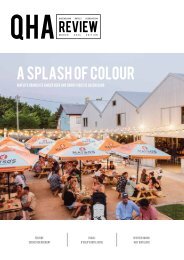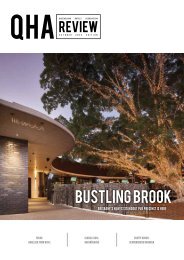QHA_April_Digital
Create successful ePaper yourself
Turn your PDF publications into a flip-book with our unique Google optimized e-Paper software.
TRAINING AND SAFETY RTO 30826<br />
with Therese Kelly<br />
HOW TO BE SURE YOU HAVE SELECTED THE CORRECT<br />
COURSE AND TRAINING ORGANISATION<br />
<strong>QHA</strong> REVIEW | 40<br />
With an increase in “phoney” RSA certificates being<br />
presented to venues, I thought it the perfect time<br />
to ensure our readers are aware of what defines a<br />
nationally accredited unit of competency.<br />
Any individual who is involved with the sale, supply or<br />
service of alcohol in licensed premises is required by<br />
law in Australia to hold a valid RSA certificate.<br />
If you want to work and serve alcohol in a licenced<br />
venue in Queensland, you must have a valid RSA<br />
QLD certificate. The following people must complete<br />
RSA training within 30 days of starting employment<br />
and maintain a current RSA training course certificate<br />
during their employment:<br />
• bartenders<br />
• glass collectors<br />
• floor staff<br />
• room service staff<br />
NOTE: It does not include people that are trained in RMLV,<br />
such as approved managers.<br />
The required certification in Queensland is a Statement<br />
of Attainment, issued on completion of the national<br />
training package competency, Provide Responsible<br />
Service of Alcohol. As a competency within a national<br />
training package, the Provide Responsible Service of<br />
Alcohol course may only be delivered by a registered<br />
training organisation (RTO).<br />
There are a few things you should know about<br />
choosing a suitable course. Firstly, there are two types<br />
of courses offered, accredited and non-accredited.<br />
Vocational education and training (VET) accredited<br />
courses have the following features<br />
Meets AQF standards<br />
Australian Qualifications Framework (AQF) is the<br />
national standard for training and education in<br />
Australia. It began in 1995 to create a baseline of<br />
quality that governs any qualification earned in the<br />
country related to schools, training programmes,<br />
higher education etc. and will contain a code that can<br />
be found on the National Register. This is one way<br />
you can be sure that it the required certification, e.g.<br />
SIT30616 Certificate III in Hospitality. VET courses<br />
have been developed by industry consultation and<br />
are accredited courses that reassure employers your<br />
skillset matches those required by industry. Accredited<br />
courses are designed specifically to meet the needs of<br />
industry ensuring all the relative laws and regulations<br />
are incorporated.<br />
What’s the difference between a non-accredited<br />
and accredited course?<br />
Courses that are non-accredited may still be useful for<br />
increasing your knowledge and skills, but they won’t<br />
help you receive an accreditation. A VET accredited<br />
course has been assessed by ASQA as compliant<br />
with the Standards for VET Accredited Courses and<br />
the AQF Courses that don’t have the VET designation<br />
and that haven’t been approved by ASQA are not<br />
accredited.<br />
How do you know if a training course is<br />
accredited?<br />
One of the best ways to see whether the course is<br />
accredited is to check the Australian Government’s<br />
website, training.gov.au. You can search for the<br />
course, then check the training provider you are<br />
researching is approved to offer the course.<br />
Who can deliver an accredited course and what<br />
does RTO mean?<br />
An RTO is a provider registered by ASQA to deliver<br />
recognised VET training and qualifications. Registration<br />
with ASQA confirms that the provider is capable of<br />
meeting government standards and is permitted to<br />
issue nationally recognised qualifications or units of<br />
competency. There are two ways you can identify an<br />
RTO. Look out for the Nationally Recognised Training<br />
logo (pictured below) and an RTO provider number<br />
(<strong>QHA</strong> RTO # 30826). An RTO number must be<br />
displayed on an RTO’s advertising materials including<br />
their website. Once you have the RTO number, search<br />
training.gov.au to ensure the organisation’s registration<br />
is current and they are approved to deliver the course<br />
you are interested in.

















